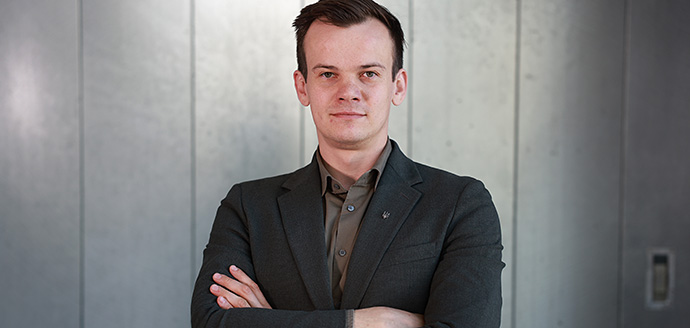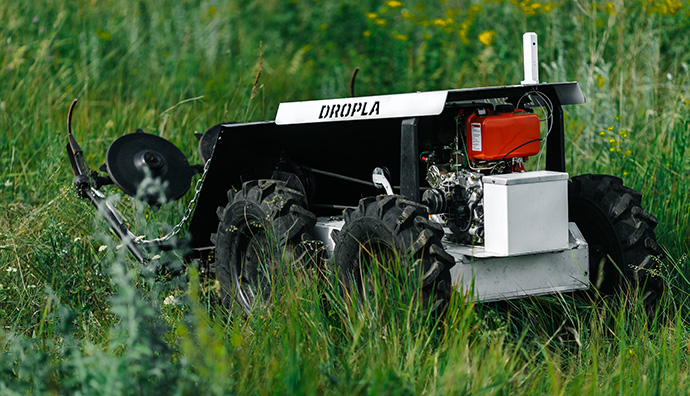Solving Ukraine's demining problem: Danish-Ukrainian startup uses robots and drones to speed up demining efforts
With current technology, it will take more than 70 years and cost 33.5 billion euros to demine Ukraine, which has a mined area of 144,000 square kilometres. Now, a Ukrainian tech entrepreneur in Denmark aims to make demining Ukraine cheaper, faster and safer.
He has moved to Odense to accelerate development of his robotics and drone solution after being selected by Odense Robotics StartUp Fund for a place at the incubator at DTI. Part of the solution is already being manufactured and tested in Ukraine.
– Ukraine is the most mined country in the world today. The current mine clearing process is painfully slow, dangerous and costly. Ukraine just doesn’t have the time to wait or money to invest, says V’yacheslav Shvaidak, co-founder and CEO of Dropla.
– With current technologies, it costs about 1-3 euros to demine one square metre. By leveraging robotics and AI, we can make demining faster, cheaper and more secure. We estimate that our solution could reduce the price of demining one square metre to 10 cents and reduce the time needed from 70 years to 12.
Demining is also a matter of food security. Prior to the Russian invasion, Ukraine was an important global food supplier, feeding more than 400 million people worldwide and accounting for 10 percent of all crops sold, according to the UN. Yet Russia’s invasion has devastated food security in the country, says the 33-year-old former lieutenant.
– Today, 26,000 square kilometres of agricultural land in liberated areas have been impacted by landmines and unexploded ordnance because of Russian aggression. That's the equivalent of half of Denmark. The agricultural land, due to its high economic output and critical importance of food security, is a number one priority to demine, says V’yacheslav Shvaidak.

V'yacheslav Shvaidak, co-founder and CEO of Dropla
How it works
Dropla is a tool to assist demining operations. The landmine detection platform combines drone swarm technology equipped with multi-modal sensor fusion and a fleet of unmanned ground vehicles that enable safety zone confirmation.
While most demining solutions use one drone at a time, Dropla deploys a swarm of six UAVs simultaneously, making it possible to cover a larger area, faster – as much as 0.5 square kilometres per day. The drones detect landmines through optical, magnetic and electromagnetic sensors and send data to a computing station, which creates a georeferenced digital surface map showing the location of threats.
Then, Dropla’s remote-controlled ground preparation UGVs remove vegetation and make sure that no threats are left undetected. These UGVs are designed to withstand a detonation of anti-personnel landmines that could have been missed in the initial survey. The result is that the land is safe for the demining squad to enter and perform demining.

Currently tested in Ukraine
The Ukrainian government’s demining organisations, the Emergency State Service of Ukraine and the State Transport Special Service, are currently testing Dropla’s UGVs.
These are manufactured by Dropla’s production team in the country and cost just 10,000 euros, a fraction of the 1.2 - 1.5 million euros cost for legacy type remote-controlled ground preparation vehicles for mine clearance.
Dropla’s neural networks are trained on data from more than 300 landmines and UXOs gathered from their own testing site in Ukraine. The combined drone swarming solution is still in development and due to be ready in six months. Dropla aims to be the biggest provider of training datasets for AI capabilities in landmine detection delivering 1.8 million labelled frames by the end of 2024.
Accelerating in Odense
Dropla has now been selected by the Odense Robotics StartUp Fund for a place at the incubator at the Danish Technological Institute (DTI).
Here, the startup will get help to strengthen his business plan, develop his technology and access funding. V’yacheslav is in no doubt that Odense and Denmark – with its wealth of expertise in robotics – is the right place to accelerate Dropla.
– I chose Odense as Dropla’s new headquarters because the city is for robotics just like Florence was for the renaissance art. There’s a critical mass of robotics, automation and drone experts here that you can’t find many other places and I want to be part of this unique nexus event. My focus now is making the sensor fusion and swarming solution ready for use in Ukraine, while strengthening the defence startup ecosystem, says V’yacheslav Shvaidak.